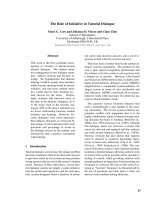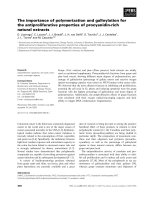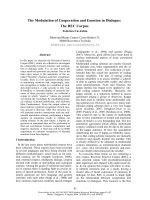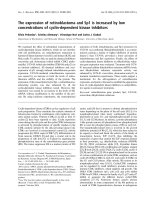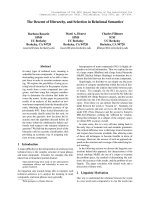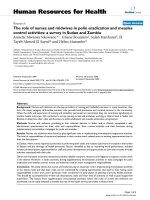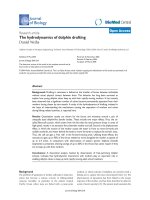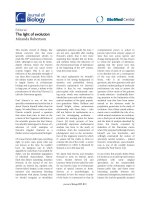Báo cáo sinh học : "The genetics of gender and life span" pdf
Bạn đang xem bản rút gọn của tài liệu. Xem và tải ngay bản đầy đủ của tài liệu tại đây (133.69 KB, 3 trang )
Minireview
TThhee ggeenneettiiccss ooff ggeennddeerr aanndd lliiffee ssppaann
John Tower and Michelle Arbeitman
Address: Molecular and Computational Biology Program, Department of Biological Sciences, University of Southern California, Los
Angeles, CA 90089-2910, USA.
Correspondence: John Tower. Email:
Differences in life span between males and females are
commonly observed across many species. For example,
where the heterogametic sex (XY sex chromosomes) is male,
as in humans and Drosophila, females tend to live longer
than males. Similarly, in Caenorhabditis elegans, where the
hermaphrodite has two X chromosomes (XX) and the male
has one (XO), the hermaphrodite tends to live longer. In
contrast, in most bird species, where the heterogametic sex
is female (ZW sex chromosomes), males tend to live longer
than females.
Genetic and environmental interventions that affect life
span tend to have a greater effect in one sex than the other
[1,2]. For example, reduced insulin/insulin-like growth
factor 1 (IGF-1) signaling and dietary restriction tend to
increase life span more in females than males in Drosophila
and mammals, whereas mild stress tends to increase life
span more in males than in females, at least in Drosophila
[3]. Quantitative genetic analyses have revealed a different
genetic architecture of life span in males versus females. For
example, quantitative trait loci (QTLs) that affect life span
are often sex-specific or sex-biased in Drosophila, mice and
humans, and studies over the past few years show strikingly
different effects of inbreeding in male versus female insects
[4,5]. Two recent studies in BMC Evolutionary Biology on the
effects of inbreeding in a seed beetle (Bilde et al. [6]) and in
Drosophila (Vermeulen et al. [7]), respectively, provide
additional insight into the genetic factors involved. Taken
together, all these data suggest that the genetic differences
between males and females have a significant effect upon
aging and life span.
AAssyymmmmeettrriicc iinnhheerriittaannccee ooff sseexx cchhrroommoossoommeess aanndd
mmaatteerrnnaall eeffffeeccttss
Several possible and potentially overlapping genetic
mechanisms have been suggested to explain differences in
life span between genders, including asymmetric inheri-
tance of sex chromosomes, differences in physiology,
maternal effects, and sex-specific selective pressures. For
example, the asymmetric inheritance of the sex chromo-
somes, such that males inherit a single X chromosome in
flies, C. elegans and humans, means that in males any X
chromosome recessive mutant phenotype will be expressed
(the ‘unprotected X’ model), whereas in females the
presence of the second X chromosome means that there is
likely to be a wild-type copy of the gene present, and the
recessive phenotype will not be expressed. These deleterious
AAbbssttrraacctt
Several possible and potentially overlapping genetic mechanisms have been suggested to
explain differences in life span between males and females. Two recent papers in
BMC
Evolutionary Biology
on the effects of inbreeding provide additional insight into the genetic
architecture underlying life span differences between genders in two different insects.
Journal of Biology
2009,
88::
38
Published: 29 April 2009
Journal of Biology
2009,
88::
38 (doi:10.1186/jbiol141)
The electronic version of this article is the complete one and can be
found online at />© 2009 BioMed Central Ltd
recessive mutations could lead to decreased life span, affect-
ing males more than females. Consistent with this idea,
inbreeding (which will tend to make recessive mutations
homozygous) has been found to cause decreased life span
in Drosophila, mice and several other species (called
inbreeding depression of life span). However, several other
studies, including that of Vermeulen et al. ([7] and see
references therein) have failed to detect inbreeding depres-
sion of adult life span, or found effects that varied depend-
ing upon the particular strain, sex, or environmental condi-
tions. For example, Vermeulen et al. mapped a recessive
QTL on the second chromosome of Drosophila that causes a
temperature sensitive reduction in life span in inbred males
but not females.
Asymmetric inheritance of mitochondrial genomes and
other cytoplasmic genomes is another possible contributor
to sex-specific differences in life span. Given that the
mitochondrial genome is inherited maternally in Drosophila
and humans, natural selection cannot act to optimize
mitochondrial function or nuclear-mitochondrial genetic
interactions in the male genetic background. This might
result in suboptimal mitochondrial function in males and
reduced life span in males relative to females [1].
The maternal effect may also contribute to differences in life
span between males and female. In many species, the
mother makes a large contribution of gene products to the
egg or embryo, and this has been shown to affect life span
in a gender-specific way in certain species. Because the
mother contributes these materials equally to eggs that will
develop as either male or female, the genetic differences
between male and female zygotes must underlie aspects of
the sex-specific effects of maternal products on life span.
One possibility is that because maternal-effect gene
products are being produced by a female genome, they may
be more optimized for female offspring, thereby contribu-
ting to the reduced life span often observed in males.
Consistent with this idea, maternal effects on life span are
greater in males than females for certain species such as the
seed beetle [8].
AAggiinngg mmeecchhaanniissmmss aanndd ttrraaddee ooffffss
Finding mechanisms that explain the difference in life span
between males and females is hindered by our lack of
understanding of the basic mechanisms of aging and
underlying causes of mortality. Life span appears to be
limited by the accumulation of irreversible damage,
probably including oxidative damage to macromolecules,
mutations, and loss of epigenetic regulation, as well as more
acute and dynamic modifiers of mortality rates, perhaps
including the efficiency of detoxification and excretion.
Mechanistic explanations often involve the concept of
trade-offs, that is, the allocation of energy or other
‘resources’ to functions such as reproduction and behavior,
at the expense of somatic maintenance pathways required
for optimal longevity. In several recent studies, however, it
was shown that life span can be increased by dietary
restriction or altered insulin/IGF-1 signaling without a
detectable decrease in reproduction or overall metabolism
[2], and conversely, reproduction can be increased in old
female flies with no detectable cost for life span [9].
Seed beetles (Figure 1) could be a particularly powerful
model in which to look for trade-offs between somatic
maintenance required for optimal life span and other traits
such as fecundity. The adult is ‘facultatively aphagous’ and
does not require food or drink, but can rely on nutrient
stores accumulated during development. Bilde et al. [6]
have examined the effects of inbreeding on male and female
life span in the species Callosobruchus maculatus. They found
that inbreeding reduced fitness of both males and females,
as indicated by reduced total reproductive output. As
expected, female life span was decreased by extreme
inbreeding, but surprisingly, male life span was increased.
Previous studies of seed beetles by Fox et al. [5] had found a
large maternal effect on life span of males but not females
[5]. However, the Bilde et al. study included an elegant
control for maternal effects, in that animals with varying
amounts of inbreeding had mothers of the same genotype,
thus separating the effects of cytoplasmic factors such as
mitochondria and maternally contributed gene products
from the effects of inbreeding. Of course, this result does
not rule out an important role for maternal products in
modulating life span, but it does show that they are not the
direct targets of the observed inbreeding effects. One
possible explanation for the decrease in female life span is
that inbreeding led to homozygosity of recessive alleles that
are deleterious for female lifespan, providing support for
the unprotected X hypothesis. However, this hypothesis
cannot account for the increase in life span observed in
males. Bilde et al. [6] suggest that the increase in male life
span might be due to changes in energy-intensive behaviors,
such as a reduction in courtship or aggression, thereby
leading to longer life span.
SSeexx ssppeecciiffiicc ggeenneettiicc aarrcchhiitteeccttuurreess
Sex-specific differences in genetic architecture could
contribute to the observed differences in life span and the
effects of inbreeding. For example, a recent study examined
how evolution shapes variation in transcript abundance in
male and female Drosophila, and sex-specific differences in
the mode of transcriptome inheritance were identified [10].
In males, variation in gene expression was found to be due
38.2
Journal of Biology
2009, Volume 8, Article 38 Tower and Arbeitman />Journal of Biology
2009,
88::
38
mostly to additive interactions of alleles, whereas in females,
gene expression variation was found to be due mostly to
non-additive (epistatic) interactions between alleles; a
substantial X-chromosome effect was shown to underlie
these differences. Similarly, in the seed beetle, loci affecting
life span exhibited more non-additive interactions (domi-
nance) in females than in males [8].
Given that additive variation responds to selection more
quickly, because additive variation does not involve inter-
actions of multiple loci, sex-specific differences in selection
could underlie aspects of sexual dimorphism in life span
observed in many species. Sex-specific selective pressures
that result in higher male reproductive fitness may contri-
bute to sexual dimorphism of life span. For example, costly
male-biased metabolism or behaviors, such as aggression or
specific courtship behaviors, might be positively selected
for, but could result in decreased life-span in males relative
to females.
Future studies may be directed toward further study of the
underlying differences in genetic architecture between males
and females, in particular, testing the idea that deleterious
alleles affecting life span may be more exposed to selection in
males than in females due to reduced non-additive effects in
males, thereby reducing inbreeding load for male-specific
deleterious alleles in the population [5]. It will be particularly
interesting to ask if the increased life span observed in highly
inbred male seed beetles by Bilde et al. [6] can be found to
correlate with a reduction in specific costly aspects of
metabolism, or behaviors such as locomotion and aggression.
AAcckknnoowwlleeddggeemmeennttss
We thank Sergey Nuzhdin for helpful discussions. This work was sup-
ported by grants from the Department of Health and Human Services
to JT (1R01AG011833) and to MA (1R01GM073039).
RReeffeerreenncceess
1. Tower J:
SSeexx ssppeecciiffiicc rreegguullaattiioonn ooff aaggiinngg aanndd aappooppttoossiiss
Mech
Ageing Dev
2006,
112277::
705-718.
2. Partridge L, Gems D, Withers DJ:
SSeexx aanndd ddeeaatthh:: wwhhaatt iiss tthhee ccoonn
nneeccttiioonn??
Cell
2005,
112200::
461-472.
3. Sorensen JG, Kristensen TN, Kristensen KV, Loeschcke V:
SSeexx
ssppeecciiffiicc eeffffeeccttss ooff hheeaatt iinndduucceedd hhoorrmmeessiiss iinn HHssff ddeeffiicciieenntt
DDrroossoopphhiillaa mmeellaannooggaasstteerr
Exp Gerontol
2007,
4422::
1123-1129.
4. Lai CQ, Parnell LD, Lyman RF, Ordovas JM, Mackay TF:
CCaannddiiddaattee
ggeenneess aaffffeeccttiinngg
DDrroossoopphhiillaa
lliiffee ssppaann iiddeennttiiffiieedd bbyy iinntteeggrraattiinngg
mmiiccrrooaarrrraayy ggeennee eexxpprreessssiioonn aannaallyyssiiss aanndd QQTTLL mmaappppiinngg
Mech
Ageing Dev
2007,
112288::
237-249.
5. Fox CW, Scheibly KL, Wallin WG, Hitchcock LJ, Stillwell RC,
Smith BP:
TThhee ggeenneettiicc aarrcchhiitteeccttuurree ooff lliiffee ssppaann aanndd mmoorrttaalliittyy rraatteess::
ggeennddeerr aanndd ssppeecciieess ddiiffffeerreenncceess iinn iinnbbrreeeeddiinngg llooaadd ooff ttwwoo sseeeedd
ffeeeeddiinngg bbeeeettlleess
Genetics
2006,
117744::
763-773.
6. Bilde T, Maklakov AA, Meisner K, la Guardia L, Friberg U:
SSeexx ddiiff
ffeerreenncceess iinn tthhee ggeenneettiicc aarrcchhiitteeccttuurree ooff lliiffeessppaann iinn aa sseeeedd bbeeeettllee::
eexxttrreemmee iinnbbrreeeeddiinngg eexxtteennddss mmaallee lliiffeessppaann
BMC Evol Biol
2009,
99::
33.
7. Vermeulen CJ, Bijlsma R, Loeschcke V:
AA mmaajjoorr QQTTLL aaffffeeccttss tteemm
ppeerraattuurree sseennssiittiivvee aadduulltt lleetthhaalliittyy aanndd iinnbbrreeeeddiinngg ddeepprreessssiioonn iinn lliiffee
s
sppaann iinn
DDrroossoopphhiillaa mmeellaannooggaasstteerr
BMC Evol Biol
2008,
88::
297.
8. Fox CW, Czesak ME, Wallin WG:
CCoommpplleexx ggeenneettiicc aarrcchhiitteeccttuurree
ooff ppooppuullaattiioonn ddiiffffeerreenncceess iinn aadduulltt lliiffeessppaann ooff aa bbeeeettllee:: nnoonnaaddddiittiivvee
iinnhheerriittaannccee,, ggeennddeerr ddiiffffeerreenncceess,, bbooddyy ssiizzee aanndd aa llaarrggee mmaatteerrnnaall
eeffffeecctt
J Evol Biol
2004,
1177::
1007-1017.
9. Li Y, Tower J:
AAdduulltt ssppeecciiffiicc oovveerr eexxpprreessssiioonn ooff tthhee
DDrroossoopphhiillaa
ggeenneess
mmaagguu
aanndd
hheebbee
iinnccrreeaasseess lliiffee ssppaann aanndd mmoodduullaatteess llaattee aaggee
ffeemmaallee ffeeccuunnddiittyy
Mol Genet Genomics
2009,
228811::
147-162.
10. Wayne ML, Telonis-Scott M, Bono LM, Harshman L, Kopp A,
Nuzhdin SV, McIntyre LM:
SSiimmpplleerr mmooddee ooff iinnhheerriittaannccee ooff ttrraann
ssccrriippttiioonnaall vvaarriiaattiioonn iinn mmaallee
DDrroossoopphhiillaa mmeellaannooggaasstteerr
Proc Natl
Acad Sci USA
2007,
110044::
18577-18582.
/>Journal of Biology
2009, Volume 8, Article 38 Tower and Arbeitman 38.3
Journal of Biology
2009,
88::
38
FFiigguurree 11
Dorsal view of male and female
Callosobruchus maculatus
.
((aa))
Male and
((bb))
female. The sex specific coloration of the posterior abdominal plate
(pygidium) is shown. The squares are 1 mm. From beanbeetles.org. Photographs by Lawrence Blumer, reproduced with permission.
(a) (b)
